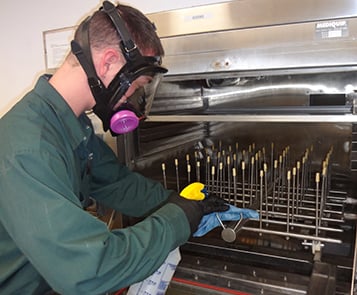Managing and maintaining the integrity of laboratories is challenging, and nothing can be more daunting to an organization than environmental, health, and safety (EHS) compliance liabilities that can exist when cleaning and decontaminating a facility. Due to the complicated and costly nature of laboratory cleanouts, it is critical for your organization to be able to identify risk and find solutions to complete the project efficiently and cost effectively. Read on to learn obstacles to be aware of before decontamination takes place.
Common Scenarios for Decontamination
There are several scenarios that might require a laboratory decontamination project. Some of the most common situations include:
- Schools and universities: Schools and universities should be cleaning out their labs as semesters end, before new, incoming students and/or professors arrive. Lab decontamination allows new sets of students/professors to start their experience fresh and not have to worry about contamination of any kind from prior experiments or testing.
- Lab moves: If your facility is changing locations, lab decontaminations are necessary. This includes relocations both off-site and internal moves. The facility you're currently moving into needs to be decontaminated, and you need to make sure the lab you're moving from is cleaned properly as well.
- Renovations: In addition to moving facilities, laboratories also need to be cleaned out if there are renovations taking place to ensure safety and compliance.
- Lab decommissioning: Decommissioning projects involve lab closures which are very restrictive due to lease contracts from the person you're renting or leasing the building from. In this case, they will typically have specific directions for how they want the lab decontaminated and steps for how to approach the process.
Liabilities Associated with Laboratory Occupancies
If you're approaching an upcoming lab decontamination project, there are certain liabilities to be aware of and consider, whether you're entering a new facility or leaving an old one.
- Entering a new facility
- Previous use
- Poor housekeeping
- Residual chemicals (surfaces, drains, HVAC, etc.)
- Unknown or poorly documented decontamination
- Exposure to contractors and occupants
- Leaving your current facility
- Lease obligations
- Uncertainty if space is properly cleaned
- Occupant and contractor safety
- Claims when vacating space
- Unexpected costs
Obstacles of Lab Decontamination
As previously stated, lab decontamination projects are complicated and in addition to the liabilities mentioned, there are other obstacles that can make the process even more difficult. Several challenges that you may face include:
- Vague lease obligations
- No set regulatory guidance
- Lack of process documentation
- Lawyers
- Responsibility of the EHS department to reduce risks and liability
Lab decontamination is a complicated process that needs to be managed by EHS experts. EHS goals within a decontamination project should include creating a smooth transition, minimizing costs, preventing and reducing potential exposures, reducing risks and liabilities, and addressing regulatory requirements.
This blog was originally published in June 2017.
